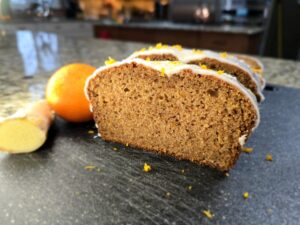Preheat the oven to 350 degrees Fahrenheit.
Line a half-sheet baking pan with parchment paper and lightly grease it.
Measuring the flour correctly is very important. Spoon the flour into the cup measure and shave off the excess flour with a butter knife without compressing it into the cup measure. Flour is very compactable, so if you simply scoop it out of the bag and not spoon it in, you will end up getting a lot more flour than needed and turning this delicate cake into a dense one. So do not skip this extra step.
Sift flour, baking powder, and salt into a small bowl. In another bowl, whisk the liquid components together.
When you separate your egg yolks and egg whites, please note that if your egg yolk breaks and makes it into your whites, they will not whip up properly, and the cake will not turn out. For this reason, I suggest separating each egg over a small bowl, then transferring it to separate yolk and white bowls. If your egg yolk happens to break and leak, do not use it. Reserve it for an omelet or another use.
Beat egg whites with a whisk attachment of your stand mixer on medium-high speed until frothy, about 2 minutes. Add cream of tartar and continue whipping until soft peaks form, about 3 minutes. With the mixer on medium speed, gradually add the sugar. It’s crucial to add the sugar slowly for the meringue to properly form; do so for a period of about 2 minutes. Beat until you reach stiff, glossy peaks, around 4 minutes. Do not overbeat. When this is overbeat, your meringue won't be smooth. Transfer your meringue to another bowl and set aside.
After Step 4, there's no need to wash the bowl of your mixer; simply wipe it with a paper towel. Add egg yolks and beat them until thickened, for about 2 minutes. Gradually add sugar at high speed; beat for another 2 minutes until lighter in color and thickened. On medium speed, pour in the oil, then add vanilla and lemon zest. Stop the mixer, scrape up the sides, and then beat everything for another 1 minute to combine.
Add the dry ingredients with the mixer running on the lowest speed, alternating with the liquids, dividing the flour into 3 parts and the liquid into 2 parts, starting and ending with the flour. Scrape the bowl with a rubber spatula. Then beat everything at low speed for 10 seconds.
Gently fold 1/3 of the whipped egg whites into the egg yolks with a whisk; this will lighten the batter and make it easier to fold in the rest. Fold in the rest of the egg whites, as well as the cooled toasted pecans, into the yolk mixture with a rubber spatula. Only fold until uniform in color and combined; do not fold any more than necessary. Pour the batter into the ungreased tube pan.
Bake in the preheated oven for about 20–22 minutes. The cake should be nice and golden, firm to touch, and spring back when gently pressed in the center.
For the stabilized whipped cream, combine gelatin and water and allow it to sit until thick, about 5 minutes. Microwave the mixture until it dissolves and becomes liquid, about 10 seconds. Allow this mixture to cool, but not for too long, as we want it in a liquid state. Add cream, sugar, vanilla, and salt to the bowl of your mixer. Beat until the mixture thickens. Then, while beating, pour in the gelatin mixture. Continue beating until medium-stiff peaks form.
After removing from the oven, set aside for 5 minutes to cool. Run a butter knife around between the cake and the baking pan. Invert the cake into a large lint-free kitchen towel, top with parchment paper, and roll the cake into a roll. Allow it to cool completely in this shape. It must be rolled into this shape while still warm to avoid cracks.
Unroll your cooled cake. Spread whipped cream over the cake. Lay the strawberries evenly on top of the cream.
Carefully roll up the cake. Wrap in plastic wrap and chill for at least 1 ½ hours in the fridge.
Ingredients
Directions
Preheat the oven to 350 degrees Fahrenheit.
Line a half-sheet baking pan with parchment paper and lightly grease it.
Measuring the flour correctly is very important. Spoon the flour into the cup measure and shave off the excess flour with a butter knife without compressing it into the cup measure. Flour is very compactable, so if you simply scoop it out of the bag and not spoon it in, you will end up getting a lot more flour than needed and turning this delicate cake into a dense one. So do not skip this extra step.
Sift flour, baking powder, and salt into a small bowl. In another bowl, whisk the liquid components together.
When you separate your egg yolks and egg whites, please note that if your egg yolk breaks and makes it into your whites, they will not whip up properly, and the cake will not turn out. For this reason, I suggest separating each egg over a small bowl, then transferring it to separate yolk and white bowls. If your egg yolk happens to break and leak, do not use it. Reserve it for an omelet or another use.
Beat egg whites with a whisk attachment of your stand mixer on medium-high speed until frothy, about 2 minutes. Add cream of tartar and continue whipping until soft peaks form, about 3 minutes. With the mixer on medium speed, gradually add the sugar. It’s crucial to add the sugar slowly for the meringue to properly form; do so for a period of about 2 minutes. Beat until you reach stiff, glossy peaks, around 4 minutes. Do not overbeat. When this is overbeat, your meringue won't be smooth. Transfer your meringue to another bowl and set aside.
After Step 4, there's no need to wash the bowl of your mixer; simply wipe it with a paper towel. Add egg yolks and beat them until thickened, for about 2 minutes. Gradually add sugar at high speed; beat for another 2 minutes until lighter in color and thickened. On medium speed, pour in the oil, then add vanilla and lemon zest. Stop the mixer, scrape up the sides, and then beat everything for another 1 minute to combine.
Add the dry ingredients with the mixer running on the lowest speed, alternating with the liquids, dividing the flour into 3 parts and the liquid into 2 parts, starting and ending with the flour. Scrape the bowl with a rubber spatula. Then beat everything at low speed for 10 seconds.
Gently fold 1/3 of the whipped egg whites into the egg yolks with a whisk; this will lighten the batter and make it easier to fold in the rest. Fold in the rest of the egg whites, as well as the cooled toasted pecans, into the yolk mixture with a rubber spatula. Only fold until uniform in color and combined; do not fold any more than necessary. Pour the batter into the ungreased tube pan.
Bake in the preheated oven for about 20–22 minutes. The cake should be nice and golden, firm to touch, and spring back when gently pressed in the center.
For the stabilized whipped cream, combine gelatin and water and allow it to sit until thick, about 5 minutes. Microwave the mixture until it dissolves and becomes liquid, about 10 seconds. Allow this mixture to cool, but not for too long, as we want it in a liquid state. Add cream, sugar, vanilla, and salt to the bowl of your mixer. Beat until the mixture thickens. Then, while beating, pour in the gelatin mixture. Continue beating until medium-stiff peaks form.
After removing from the oven, set aside for 5 minutes to cool. Run a butter knife around between the cake and the baking pan. Invert the cake into a large lint-free kitchen towel, top with parchment paper, and roll the cake into a roll. Allow it to cool completely in this shape. It must be rolled into this shape while still warm to avoid cracks.
Unroll your cooled cake. Spread whipped cream over the cake. Lay the strawberries evenly on top of the cream.
Carefully roll up the cake. Wrap in plastic wrap and chill for at least 1 ½ hours in the fridge.









